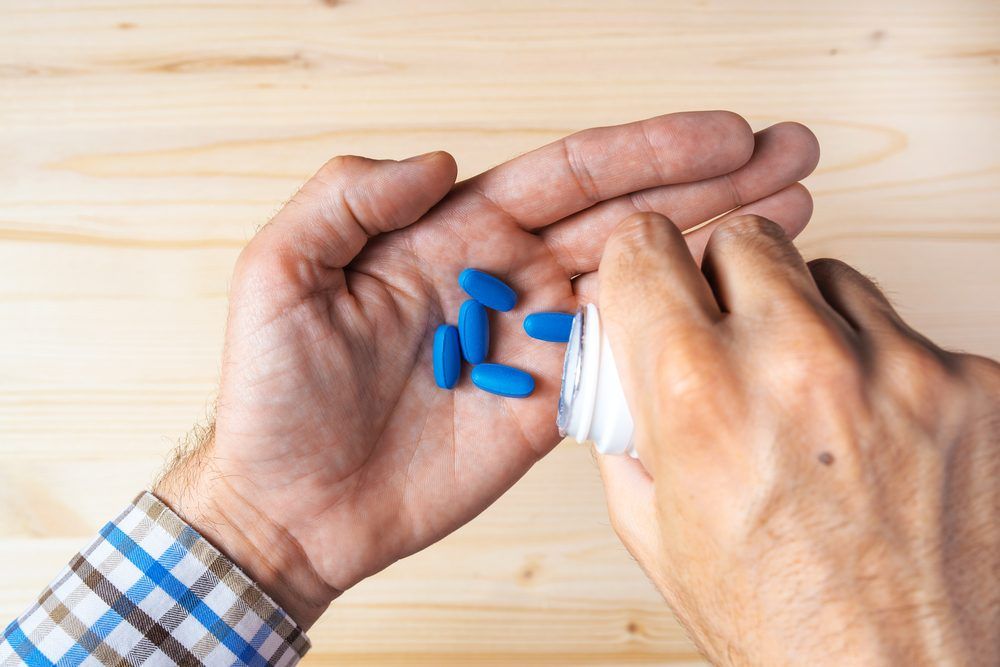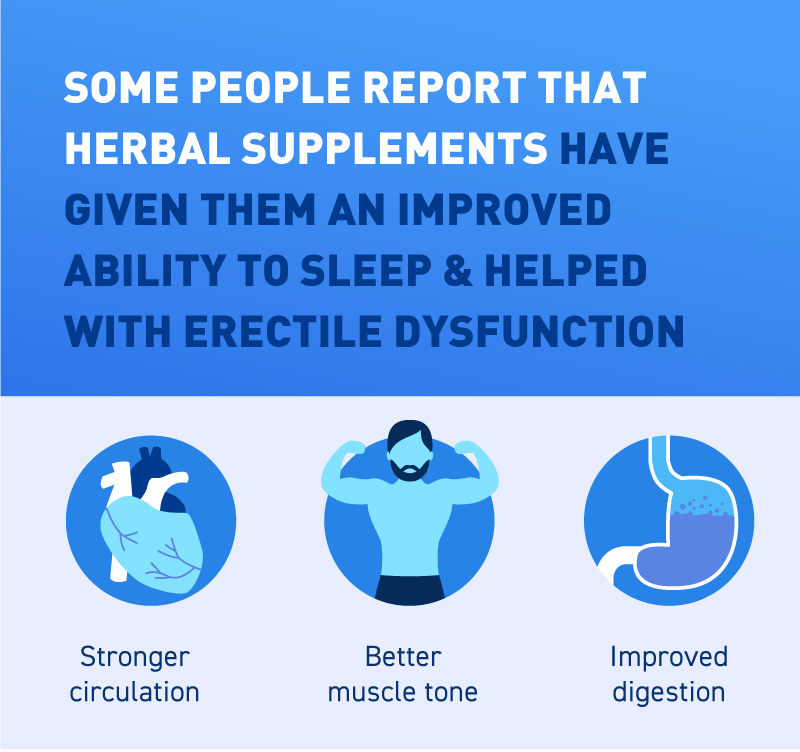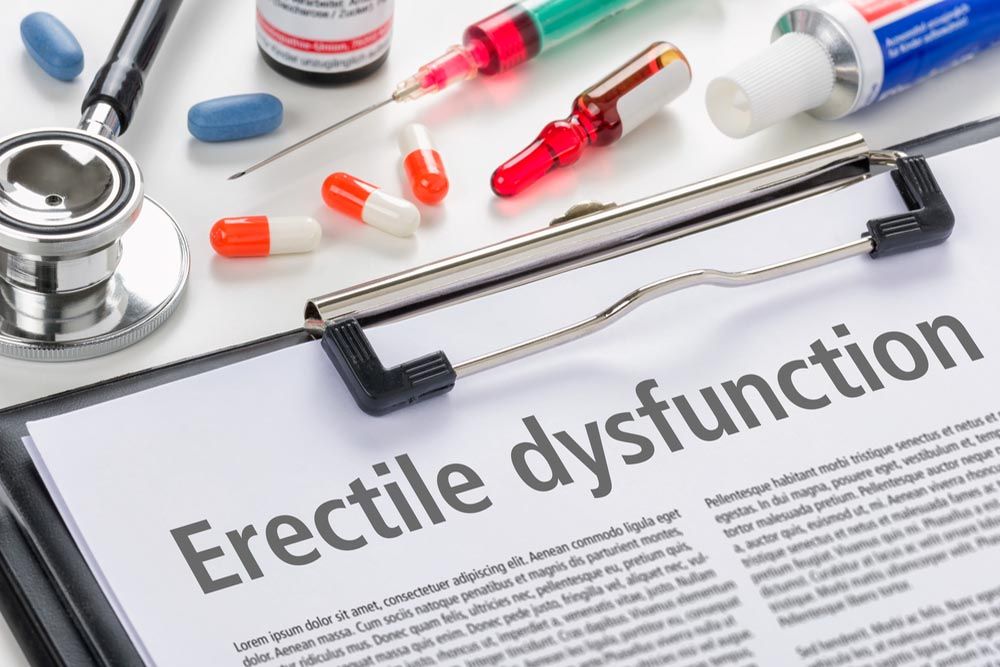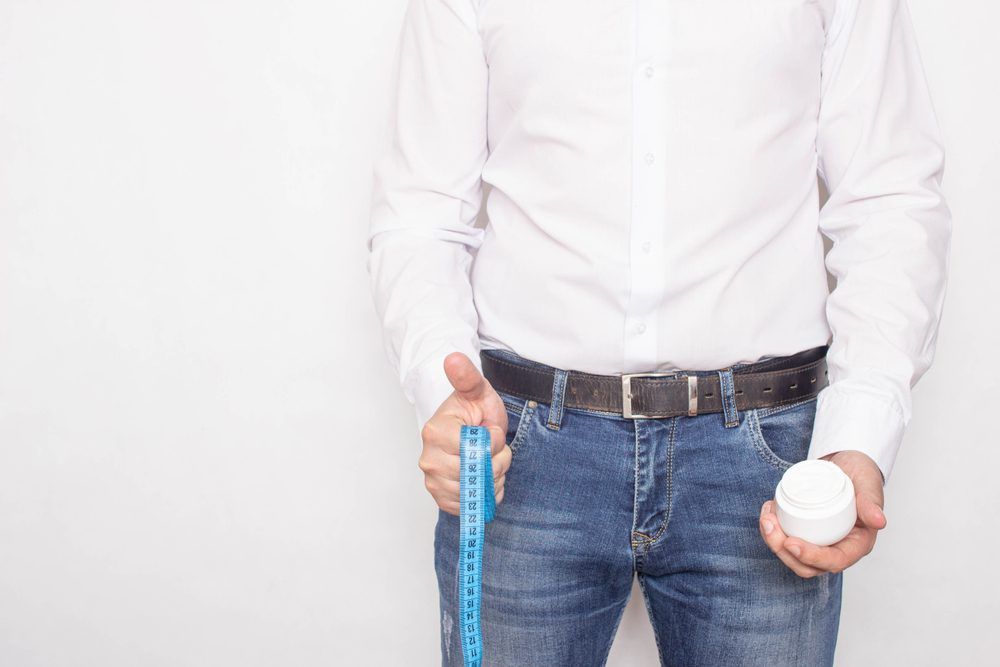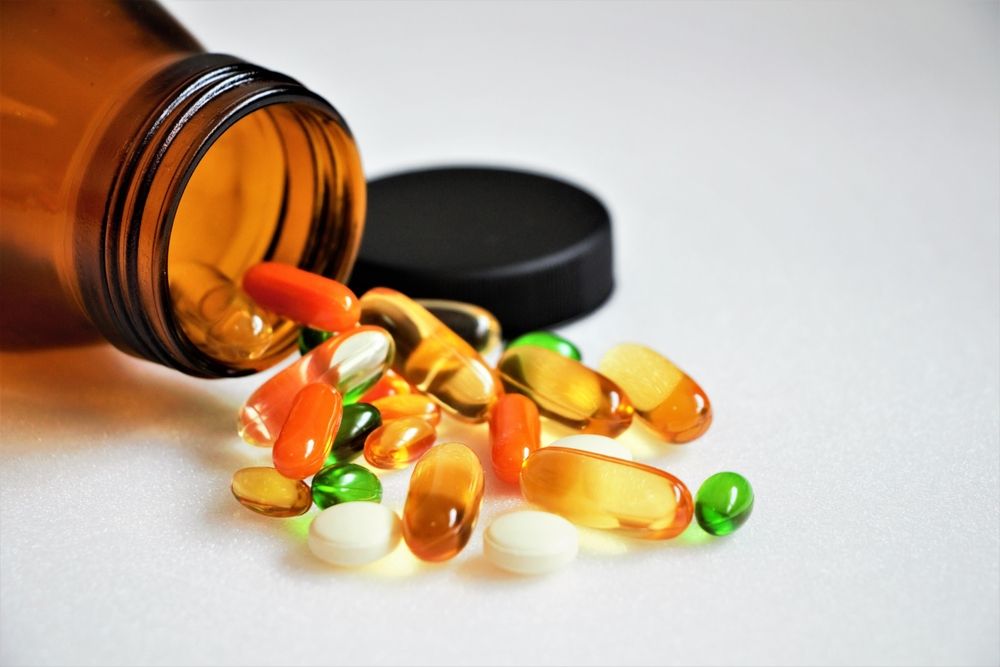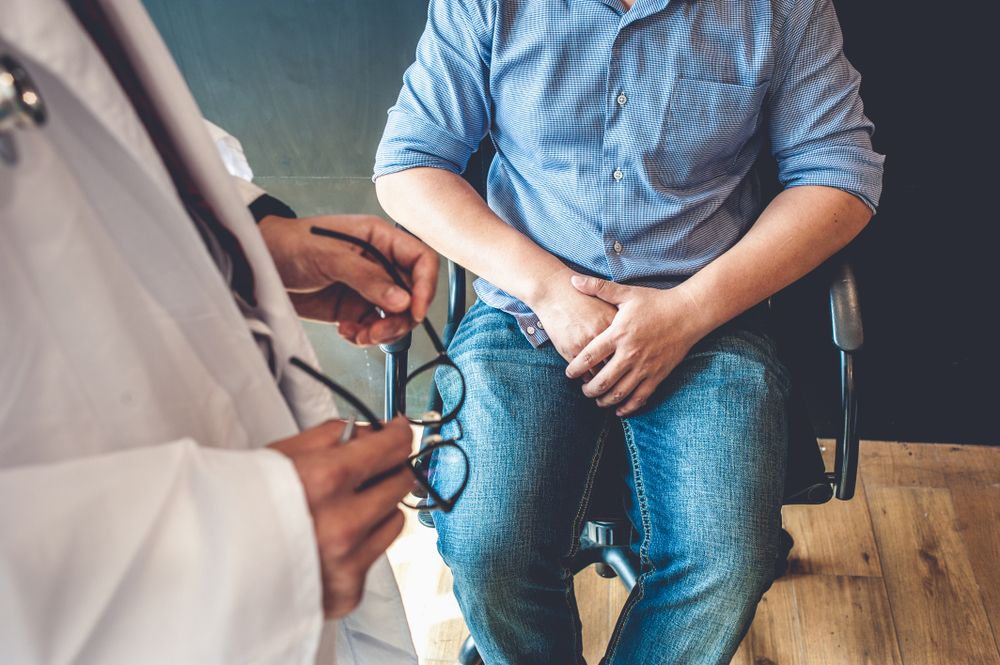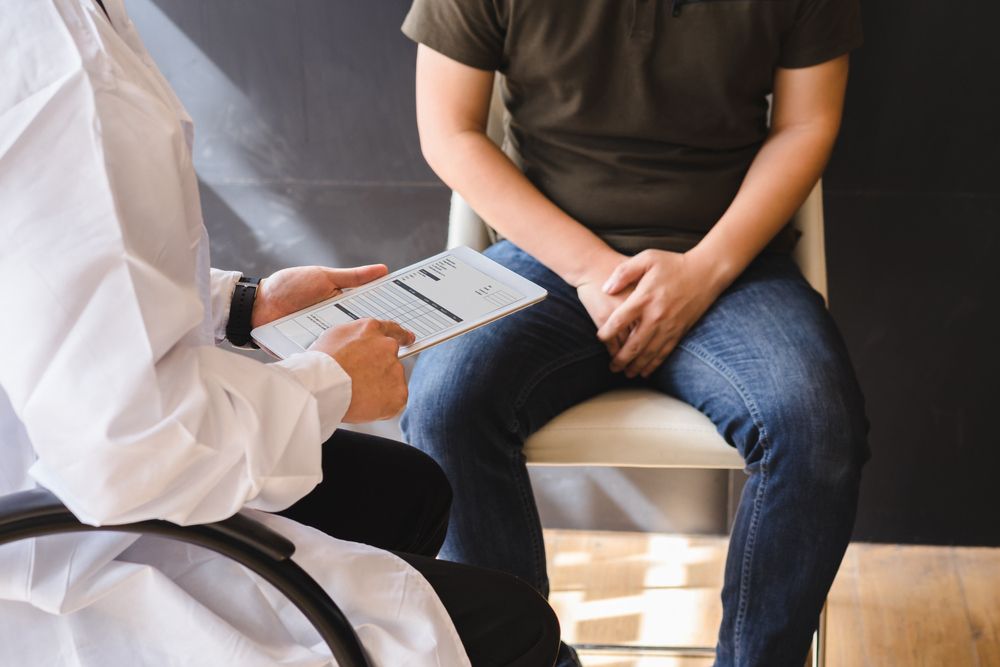Erectile dysfunction (ED) is a common problem among men.
While it can become more common as men age, it is not specifically related to age. Instead, it involves hormones, physical health, mental health, and other underlying causes. (Learn More)
Erectile dysfunction can also be a symptom of underlying conditions, including heart disease, diabetes, depression, anxiety, or injury. (Learn More)
This condition is first diagnosed by speaking with your doctor about how frequently you experience symptoms. You’ll then receive a physical exam to better understand if there are underlying chronic health problems contributing to the condition.
Then, blood tests, urine tests, and even sleep tests can all be used to determine the extent of ED. These tests can indicate whether physical or mental struggles may be the main cause of ED. (Learn More)
There are several medical treatments that can help erectile dysfunction. The FDA approved Viagra in 1998 for this purpose. (Learn More)
There are also home remedies, lifestyle changes, and counseling that can ease symptoms and improve overall physical health, which can make ED symptoms less intense. (Learn More)
The most important point is to remember that erectile dysfunction is common. There is no reason to be ashamed, so speak with your doctor about potential remedies. (Learn More)
What Is Erectile Dysfunction?
The term erectile dysfunction (ED) refers to the inability of a man to get an erection and keep it throughout sexual activity. The condition is also sometimes called impotence.
ED is not a primary condition. It’s a secondary condition that can indicate an underlying condition. It may be the first sign of a different chronic medical condition.
Occasional difficulty getting or sustaining an erection is normal in all men, and it is not the same as erectile dysfunction. ED is a very common condition itself, but it is frequently misunderstood.
ED can affect any man of any age. It has more to do with a range of physical and mental complications than just getting older. About 50 percent of men between the ages of 40 and 70 are somewhat affected by some form of ED. While the percentage increases with age, ED is not directly impacted by age.
It is also not a sign that a man is no longer sexually or romantically interested in his partner.
If you have consistent trouble getting or maintaining an erection, regardless of sexual interest, you may struggle with ED. There are many treatments available, so speak to a doctor if you have concerns about your ability to have an erection, especially since ED can indicate another underlying illness.
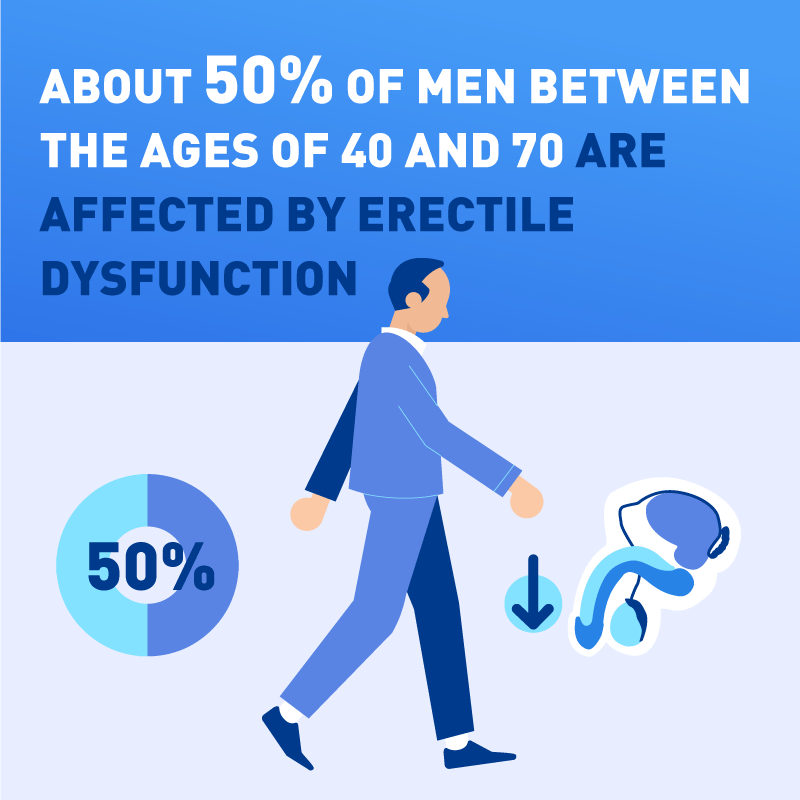
The Symptoms of Erectile Dysfunction
The process of sexual arousal in men is a complex process involving the brain, emotions, hormones, nerves, blood vessels, and skeletal muscles. Nearly every organ system plays a role in feeling well and enjoying sexual arousal.
Achieving an erection requires adequate blood flow to the penis, first and foremost, with a slowing of blood flow out due to sexual arousal and nerve stimulation. Mental, physical, and behavioral health concerns, including medication, previous health problems, and safety at home, can all contribute to trouble getting or maintaining an erection.
Common symptoms of erectile dysfunction include:
- Trouble getting an erection regardless of sexual interest.
- Being able to get an erection sometimes but not in other cases.
- Getting an erection that doesn’t last long enough for intercourse.
- Trouble maintaining an erection.
- Reduced sexual desire.
You may also have ED if you experience premature or delayed ejaculation.
If you have other symptoms along with ED, you could have an underlying condition like heart disease or diabetes. Trouble experiencing sexual arousal or maintaining an erection can also indicate problems with mental or behavioral health, including depression, post-traumatic stress disorder, or high stress and anxiety.
Potential Underlying Causes of Erectile Dysfunction
Many of the underlying causes of erectile dysfunction are related to physical conditions.
- Heart disease
- Arteriosclerosis (clogged blood vessels)
- High cholesterol
- High blood pressure
- Diabetes
- Obesity
- Metabolic syndrome (high blood pressure, cholesterol, and blood sugar, increased insulin, along with body fat particularly around the midsection)
- Chronic kidney disease
- Parkinson’s disease
- Multiple sclerosis
- Peyronie’s disease, or scar tissue inside the penis
- Some prescription medications, like antiandrogens, sedatives, antidepressants, or blood pressure medications
- Cancer treatments
- Prostate enlargement
- Surgeries or injuries affecting the pelvis or spinal cord, particularly for bladder cancer
The first connection between heart disease and ED as a symptom of this problem was uncovered in 1997. It was the result of a landmark study of 1,709 men over a 10-year period. The study not only showed a connection between ED and heart disease, but it also correlated ED with diabetes mellitus, smoking, and dyslipidemia. This appears to be related to the role of epithelial cells in heart health, along with other organ health.
There are mental and behavioral conditions that impact the ability to maintain an erection.
- Anxiety, depression, or PTSD
- Insomnia or other sleep difficulties
- Substance abuse, including smoking or drinking too much
- Relationship struggles, including intimate partner violence
- Stress due to poor communication, financial problems, and major life changes
Complications from struggling with ED can make symptoms worse by adding stress and shame to your romantic and sexual life.
Seeing a general practitioner and discussing your symptoms will help you begin to overcome this issue. Once you get the right medical diagnosis and treatment plan, you can move forward.
How Erectile Dysfunction Is Diagnosed
Treating ED begins with prevention, as much as possible. Getting accurate diagnoses for underlying medical problems like diabetes, hypertension, heart disease, and mental health conditions like depression can begin the process of improving your overall health, which can ease ED symptoms.
Take these preventative steps:
- Manage chronic conditions with medication.
- Go to regular checkups and get screenings for the conditions you are at risk for.
- Stop smoking and abusing substances. Drink moderately, if at all.
- Get exercise regularly.
- Eat healthy foods and manage your weight.
- Take steps to reduce stress.
- Develop a treatment plan for mental or behavioral conditions, including antidepressants and talk therapy as appropriate.
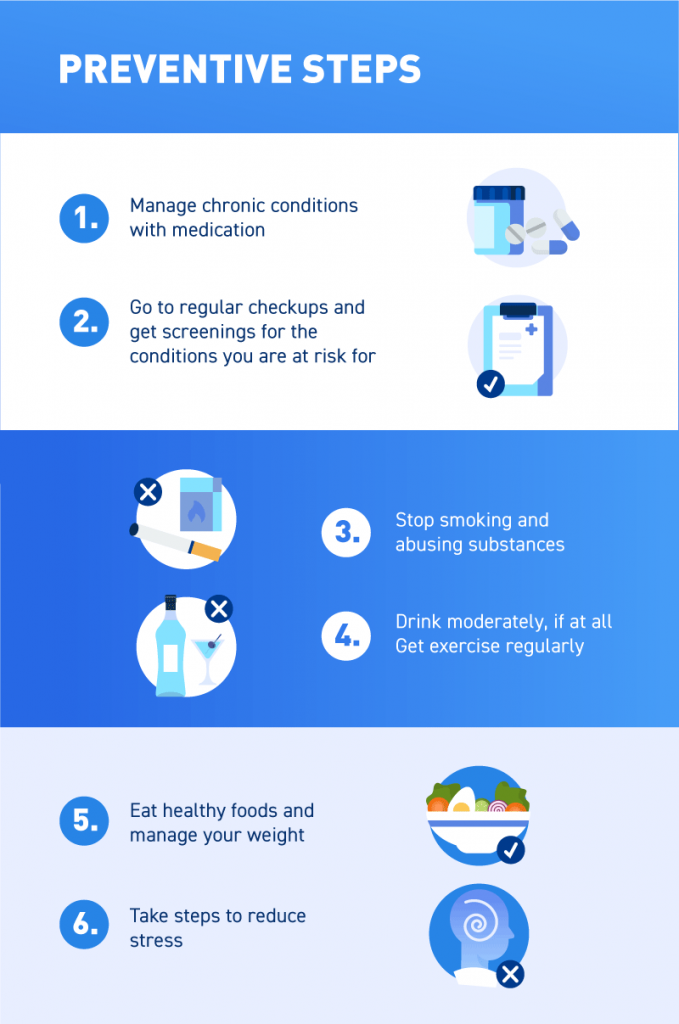
Diagnosing erectile dysfunction begins by meeting with your doctor to discuss your symptoms and getting a physical exam. Your doctor may then perform additional tests.
- Blood tests: A blood test checks for low testosterone, cholesterol levels, diabetes, and other potential health conditions.
- Urine tests: These can be a less invasive method of finding underlying conditions like diabetes, kidney disease, or bladder problems that may contribute to ED.
- Ultrasound: This test in men can check blood vessels in and around the penis to detect blood flow problems. Your doctor may use an injected medication to stimulate blood flow and see if you can get an erection.
- Psychological exam: This can help your general practitioner determine if an antidepressant or referral to therapy might help your mental state, stress-level, and personal feeling of safety and security.
- Overnight erection test: Men typically experience erections during their regular sleep cycle, but they do not realize it. This specialized sleep test involves wrapping a particular kind of tape around the penis before bed. If the tape is separated in the morning, that means the penis was erect at least once during the night, and it suggests that the cause of ED may be psychological or behavioral rather than physical.
- Testosterone and androgen level tests: Low testosterone is associated with ED and low sexual arousal levels, but medical research is increasingly finding that androgen deficiency is associated with testosterone deficiency. A study of men between 30 and 79 years old found that 24 percent had low testosterone levels, and 5.6 had symptomatic androgen deficiency.
Medications That Treat Erectile Dysfunction
Once you receive a diagnosis for potential underlying conditions, treatment for ED typically involves oral medications.
- Sildenafil (Viagra): This is a drug in a class of phosphodiesterase (PDE) inhibitors, created to improve blood flow for safe, healthy exercise in adults with pulmonary arterial hypertension (PAH), which makes blood flow and breathing more difficult. Viagra was approved to treat ED in 1998, and it was the first medication of its kind on the market.
Viagra improved blood flow to extremities too, including the penis. It has been shown to improve sexual stimulation and the ability to maintain an erection in many men.
This drug comes as a tablet or liquid suspension, which can be taken by mouth. Viagra mostly comes in a pill form as a prescription. It should be taken about an hour before sexual activity, and lasts about six hours. - Tadalafil (Adcirca, Cialis): This drug treats symptoms of ED, and it can be used to treat benign prostatic hyperplasia (BPH), which is caused by an enlarged prostate. It can also treat symptoms of PAH, just like Viagra.
Tadalafil is prescribed as a tablet to be taken by mouth, with or without food, about 30 minutes before sexual activity. It is effective for as long as 36 hours. It should not be taken more than once every 24 hours.
The Food and Drug Administration (FDA) approved this medication in 2003. - Vardenafil (Levitra, Staxyn): Like Viagra, Levitra was originally developed as a PDE inhibitor, which increases blood flow to the penis during sexual stimulation. However, this medication does not cure erectile dysfunction, especially when there is another underlying cause, nor does it increase sexual desire. Instead, it works with existing sexual desire and stimulation.
This drug is prescribed as a tablet, and it can dissolve in the mouth with or without water. It does not need to be taken daily. It should be taken as needed, about an hour before sexual activity may occur. It remains effective for about seven hours. It should not be taken more than once every 24 hours.
Like tadalafil, the FDA approved this drug for prescription use in 2003. - Avanafil (Stendra): This PDE medication increases blood flow to the penis during sexual stimulation, just like the previously listed medications. Stendra can be taken 15 to 30 minutes prior to sexual activity, and it lasts for about six hours. These pills should not be taken more than once in 24 hours.
Each of these medications enhances your body’s natural production of nitric oxide, which relaxes the muscles of the penis. By managing how much of this chemical your body makes, your body will be better able to get an erection in response to sexual stimulation.
Taking these medications does not automatically produce an erection. They rely on the release of nitric oxide from the penile nerves through sexual stimulation. They then amplify the “signals” of these chemicals, which can improve your ability to get and maintain an erection.
Although ED medications work on the same basic chemical, they each vary in dosage and side effects, so they work differently for different individuals. The following are common side effects from these medications:
- Facial flushing
- Headaches
- Nasal congestion
- Backaches
- Visual changes
- Upset stomach
If any of the above medications do not work for you, other options include:
- Testosterone therapy. Erectile problems may begin with low testosterone, a condition that can also have several root causes. Taking testosterone supplements may improve overall health — not just erectile function, but mental and physical health too.
- Alprostadil self-injections. You will inject a generic drug alprostadil (available under the brand names Caverject Impulse and Edex) into the base side of the penis. The injection can include another medication like papaverine or phentolamine, either as a bimix (two medications together) or trimix (three medications together).
Each injection lasts no longer than an hour. The needle is fine enough that pain at the injection site is minimal. - Alprostadil urethral suppository. Under the brand name Muse, you place a small suppository of the generic drug alprostadil inside the penile urethra using a special applicator. Effects begin in about 10 minutes, and they can last for 30 to 60 minutes.
Natural and Lifestyle Remedies That Improve Erectile Dysfunction
In addition to medication, treating underlying conditions, and making healthy lifestyle changes, some natural remedies may be able to improve erectile function. For example, Kegel exercises can strengthen and tone pelvic muscles. This can improve erections and improve urinary function and both urinary and fecal incontinence.
Some people report that herbal supplements have given them an improved ability to sleep, stronger circulation, better muscle tone, and improved digestion. Herbal supplements may help erectile dysfunction symptoms.
Yohimbe is the bark of an evergreen native to western Africa. This bark is used in extracts, capsules, and tablets. It has been used for years as an aphrodisiac, which is said to increase sexual desire; however, some people report no effects from aphrodisiacs. There is also little information on yohimbe as a dietary supplement and how this may interact with other medications. The herb has also been associated with seizures and heart attacks, so if you have underlying conditions that cause ED, you may not be a good candidate to take this supplement.
Speak with your doctor before taking any herbal remedies, especially if you take other prescription drugs.
Counseling is also an important part of ED treatment, especially couples counseling. Between 5 and 20 sessions with a counselor, individually and as a couple, have been shown to resolve many of these problems associated with ED.
A Common Problem Among Men in the United States
The first stem cell treatments for ED were examined in 2004, but for now, medication on an as-needed basis appears to be the best remedy for men experiencing erectile dysfunction, especially without underlying conditions.
It is important to go to a doctor first. You can get a prescription medication to improve your erections, but even more importantly, they can determine if you have an underlying condition like heart disease or diabetes that requires a very different, long-term approach to treatment.
Every man experiences erectile problems on occasion, as sexual arousal is not limited to an erection. Several physical and mental factors together create the ability for a man to experience consensual sexual arousal and an erection. However, if this problem continues regularly or gets worse, it could indicate another issue that can benefit from treatment.
References
Erectile Dysfunction. (March 9, 2018). Mayo Clinic.
Erectile Dysfunction. American Sexual Health Association (ASHA).
Erectile Dysfunction. (August 2017). Merck Manuals: Consumer Version.
Symptoms and Causes of Erective Dysfunction. (July 2017). National Institute of Diabetes and Digestive and Kidney Diseases (NIDDK).
Recent Advances in the Treatment of Erectile Dysfunction. (October 25, 2017). British Medical Journal (BMJ), Postgraduate Medical Journal.
Erectile Dysfunction (ED). (July 2013). Center for Integrated Health, VA Health Care.
Erectile Dysfunction: Viagra and Other Medications. (June 6, 2015). Mayo Clinic.
Sildenafil. (January 15, 2018). MedlinePlus.
Tadalafil. (April 15, 2016). MedlinePlus.
Vardenafil. (April 15, 2016). MedlinePlus.
Avanafil. (February 15, 2017). MedlinePlus.
Men’s Health. (October 17, 2018). Mayo Clinic.
Yohimbe. (September 2016). National Center for Complementary and Integrative Health (NCCIH).

